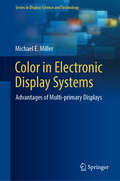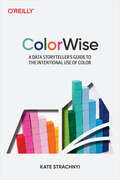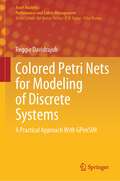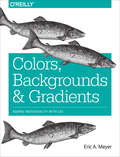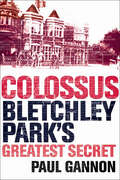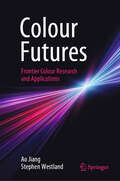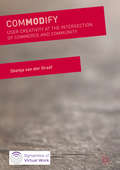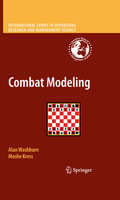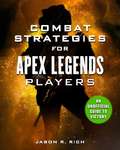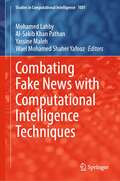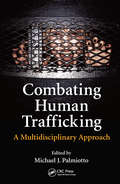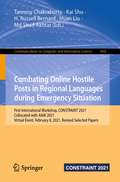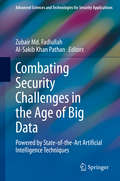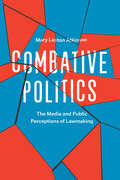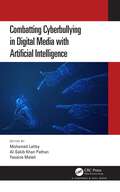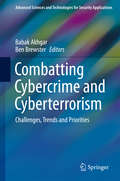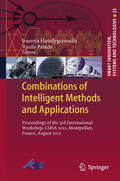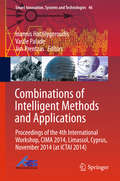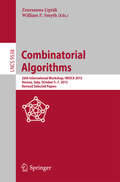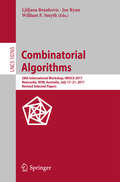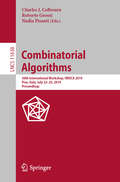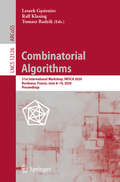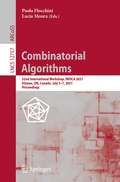- Table View
- List View
Color in Electronic Display Systems
by Michael E. MillerThis book explores the principles, design, and image processing of multi-primary displays, and introduces the reader to the intricacies of the typical imaging pathways which influence display design and the perception of color within a display system. Early chapters introduce the concepts behind human perception, color science, and lighting, which are necessary to fully understand multi-primary displays. The reader is also introduced to digital capture and transmission systems to better understand the ecosystem in which multi-primary displays exist. Subsequent chapters introduce the reader to current display technologies, including LCD, OLED, and inorganic LED displays. The working principles, performance, and upcoming advances are discussed for each of these technologies to provide the reader with a clear understanding of the tradeoffs which are necessary when considering multi-primary displays. This discussion is followed by an in-depth discussion of the image processing technology necessary to implement multi-primary displays. The book concludes with chapters that clearly discuss the advantages and limitations of multi-primary displays for direct view, virtual reality, and augmented reality displays. The book provides a broad viewpoint across the entire display ecosystem, explaining the interactions among system components to provide a rationale for the further development of multi-primary displays. Whether the reader is interested in broadening their understanding of display systems or the development of multi-primary displays, the text provides and understandable and practical summary of important display system concepts.
ColorWise: A Data Storyteller's Guide to the Intentional Use of Color
by Kate StrachnyiData has become the most powerful tool in business today, and telling its story effectively is critical. Yet one of the best communicators—color—is the most neglected tool in data visualization. With this book, DATAcated founder Kate Strachnyi provides the ultimate guide to the correct use of color for representing data in graphs, charts, tables, and infographics.Ideal for data and business analysts, data scientists, and others who design infographics and data visualizations, this practical resource explores color tips and tricks, including the theories behind them and why they work the way they do. ColorWise covers the psychology, history, and culture of many different colors. This book is also a useful teaching tool for learning about proper use of color for data storytelling techniques and dashboarding.You'll explore:The role that color theory plays in data visualization and storytellingVarious color techniques you can use to improve data visualizationsHow colors affect your audience's understanding of data visualizationsHow to use color intentionally to help guide your audienceTips for using colors that people with color vision deficiency can interpretHow to apply the book's guidelines for use in your own projects
Colored Petri Nets for Modeling of Discrete Systems: A Practical Approach With GPenSIM (Asset Analytics)
by Reggie DavidrajuhThis book offers a practical approach to modeling real-world discrete systems and performing analysis. The theory behind the book is the Colored Petri nets, and the tool used for simulations is general-purpose Petri net simulator (GPenSIM). The theory part is kept to a minimum, and more explanation is given to the GPenSIM functions and how they can be used for modeling, simulation, and performance analysis. Real-world industrial systems possess a large number of resources. Modeling these systems with Petri nets would become a problem as they result in huge Petri net models. This book offers a unique solution to this problem by moving resources away from the Petri net model and treating them as variables in the background. Also, the theory and practice put forward in the book help cost estimation of the systems (e.g., manufacturing subsystems).
Colors, Backgrounds, and Gradients: Adding Individuality with CSS
by Eric A. MeyerOne advantage of using CSS3 is that you can apply colors and backgrounds to any element in a web document, create your own gradients, and even apply multiple backgrounds to the same element. This practical guide shows you many ways to use colors, backgrounds, and gradients to achieve some pretty awesome effects.Short and sweet, this book is an excerpt from the upcoming fourth edition of CSS: The Definitive Guide. When you purchase either the print or the ebook edition of Colors, Backgrounds, and Gradients, you’ll receive a discount on the entire Definitive Guide once it’s released. Why wait? Learn how to bring life to your web pages now.Define foreground colors for a border or element with the color propertyCombine foreground and background colors to create interesting effectsPosition and repeat one or more images in an element’s backgroundFix an image to a screen’s viewing area, rather than to the element that contains itUse color stops to define vertical, horizontal, and diagonal linear gradientsCreate spotlight effects, circular shadows, and other effects with radial gradients
Colossus: Bletchley Park's Greatest Secret
by Paul GannonIn 1940, almost a year after the outbreak of World War II, Allied radio operators at an interception station in South London began picking up messages in a strange new code. Using science, math, innovation, and improvisation, Bletchley Park code breakers worked furiously to invent a machine to decipher what turned out to be the secrets of Nazi high command. It was called Colossus. What these code breakers didn't realize was that they had fashioned the world's first true computer. When the war ended, this incredible invention was dismantled and hidden away for almost 50 years. Paul Gannon has pieced together the tremendous story of what is now recognized as the greatest secret of Bletchley Park.
Colour Futures: Frontier Colour Research and Applications (Vision, Illusion and Perception #5)
by Stephen Westland Ao JiangThis book delves into the nuanced interplay of colour in human perception and its applications across diverse fields, highlighting the transformative impact on art, design, digital media, and technology. The book introduces an innovative approach by integrating scientific research with practical applications, making it a pivotal resource for designers, psychologists, and technologists. Its scope ranges from foundational aspects of colour vision to futuristic applications in virtual reality and artificial intelligence, offering fresh insights and forecasting emerging trends. This comprehensive exploration is essential for anyone interested in the strategic use of colour to enhance user experience and cultural expressions.
Colour for Web Design: Apply Colour Confidently and Create Successful Websites
by Cameron ChapmanColour is one of the most powerful tools at a designer's disposal, yet few truly understand how much it can do for them, and the immediate difference it will make to the popularity and success of their website.This is the complete guide to creating a unique, practical and appropriate colour palette for any web design project. Building on the basics, starting with essential - often misunderstood - terminology and an understanding of traditional colour palettes, the book then moves on to practical, real-world examples of sites with fantastic colour schemes.A one-stop shop for a complete knowledge of digital colour, this book will give the designer the confidence to create their own palettes and apply colour successfully to their designs.
ComMODify: User Creativity at the Intersection of Commerce and Community (Dynamics of Virtual Work)
by Shenja van der GraafThis book critically analyses user-firm technology relationships and socioeconomic structures at the crossroads of community and commerce. It investigates businesses that let users participate in platform development on the internet. An empirical study of the online world Second Life is used as an early illustration of the pivotal role of user participation in design, development and sustainability of digital platforms. Van der Graaf sheds light on aspects of the ongoing platformization of the internet and on new norms and mechanisms for user participation which are linked to values of creativity, community and labour. ComMODify makes clear that robust theoretical and empirical investigation of the integration of user participation into mainstream business models and its implications for platform development is key to understanding contemporary businesses like Facebook, that sustain the internet of today. This book will be of interest to those wanting to learn more about the socio-economic implications of user participation associated with user-generated content, particularly within the 3D software and game industry.
Combat Modeling (International Series in Operations Research & Management Science #134)
by Alan Washburn Moshe Kress"Combat Modeling" is a systematic learning resource and reference text for the quantitative analysis of combat. After a brief overview, authors Washburn and Kress present individual chapters on shooting without feedback; shooting with feedback; target defense; attrition models; game theory and wargames; search; unmanned aerial vehicles; and terror and insurgency. Three appendices provide a review of basic probability concepts, probability distributions, and Markov models; an introduction to optimization models; and a discussion of Monte-Carlo simulations. Drawing on their many years of experience at the Naval Postgraduate School in Monterey, California, Washburn and Kress have created a reference that will provide the tools and techniques for analysts involved in the underpinnings of combat decisions. This is a book that can be used as a military manual, reference book, and textbook for military courses on this vital subject.
Combat Strategies for Apex Legends Players: An Unofficial Guide to Victory
by Jason R. RichThe Tell-All, Essential Guide for the Hottest Game of 2019!Combat Strategies for Apex Legends Players is a full-color, information-packed strategy guide designed to quickly get newbs (beginners) acquainted with the many intricacies of the game, while teaching more advanced and proven exploration, survival, and combat strategies to experienced gamers looking to improve their kill-rate, familiarity with weapons, and survival skills.Combat Strategies for Apex Legends Players offers an easy-to-read format that showcases hundreds of full-color screenshots from the PC, Xbox One, and PS4 versions of the game to help you master EA’s Apex Legends and get the most out of your gameplay experience. Each section of this vital handbook focuses on one important element or aspect of the game, allowing you to make intelligent decisions when: Choosing your LegendBuilding an arsenalWorking with squad matesExploring Kings Canyon,Fighting and consistently winning matchesAnd more! Get the scoop early and beat the competition for Apex Legends with the indispensable knowledge you gain from Combat Strategies for Apex Legends Players!
Combating Crime on the Dark Web: Learn how to access the dark web safely and not fall victim to cybercrime
by Nearchos NearchouKnow your enemy and counter the dark web criminality with this easy-to-follow guide, including a detailed tour of the dark web ecosystem and the tools and tactics used to mitigate cyber threatsKey FeaturesGet up to speed with the ins and outs of cybercriminal activity on the dark webBecome familiar with the tools and techniques that are used to fight serious crimeGain a keen understanding of the crime ecosystem on the dark web and the best practices to keep it in checkBook DescriptionIn today's world, the crime-prevention landscape is impossible to navigate. The dark web means new frontiers of combat against bad actors that pop up daily. Everyone from narcotics dealers to human traffickers are exploiting the dark web to evade authorities. If you want to find your feet in this tricky terrain and fight crime on the dark web, take this comprehensive, easy-to-follow cyber security guide with you.Combating Crime on the Dark Web contains everything you need to be aware of when tackling the world of the dark web. Step by step, you'll gain acumen in the tactics that cybercriminals are adopting and be equipped with the arsenal of strategies that are available to you as a cybersecurity specialist.This cyber security book ensures that you are well acquainted with all the latest techniques to combat dark web criminality. After a primer on cybercrime and the history of the dark web, you'll dive right into the main domains of the dark web ecosystem, reaching a working understanding of how drug markets, child pornography, and human trafficking operate. Once well-versed with the functioning of criminal groups, you'll be briefed on the most effective tools and methods being employed by law enforcement, tech companies, and others to combat such crimes, developing both a toolkit and a mindset that can help you stay safe from such criminal activities and can be applied in any sector or domain. By the end of this book, you'll be well prepared to begin your pushback against the criminal elements of the dark web.What you will learnUnderstand the history of cybercrime, the dark web, and the use of TorDiscover the ecosystem of dark web drug marketsBecome familiar with the methods law enforcement use to stop child abusersDive deep into real-life human trafficking cases and how they were tackledExplore sting operations, honeypots, and cybercrime prevention methodologiesGain expertise in Pipl Search, MEMEX, BITCRIME, and other anti-crime toolsInvestigate open-source intelligence and intelligence-led policingSet up a framework for disrupting organized crime on the dark webWho this book is forThis book is for aspiring cybercrime investigators, cybersecurity enthusiasts, and anyone else who is interested in learning about this dark side of the internet. The book mainly focuses on preventing crimes on the dark web and is written in a simple way so that you can understand it with ease.
Combating Fake News with Computational Intelligence Techniques (Studies in Computational Intelligence #1001)
by Al-Sakib Khan Pathan Yassine Maleh Mohamed Lahby Wael Mohamed Shaher YafoozThis book presents the latest cutting-edge research, theoretical methods, and novel applications in the field of computational intelligence techniques and methods for combating fake news. Fake news is everywhere. Despite the efforts of major social network players such as Facebook and Twitter to fight disinformation, miracle cures and conspiracy theories continue to rain down on the net. Artificial intelligence can be a bulwark against the diversity of fake news on the Internet and social networks. This book discusses new models, practical solutions, and technological advances related to detecting and analyzing fake news based on computational intelligence models and techniques, to help decision-makers, managers, professionals, and researchers design new paradigms considering the unique opportunities associated with computational intelligence techniques. Further, the book helps readers understand computational intelligence techniques combating fake news in a systematic and straightforward way.
Combating Human Trafficking: A Multidisciplinary Approach
by Michael J. PalmiottoApproaching the topic from a law enforcement perspective, this volume provides an unprecedented look at the investigation of human trafficking in America. Beginning with historical, sociological, and psychological perspectives, the book discusses how authorities can best conduct an investigation of trafficking. It reviews federal agencies responsible for confronting the problem, examines relevant laws and legal trends, and discusses law enforcement awareness and training. An ideal resource for police investigators, police training, and community outreach organizations, the book is also suitable as a college text for criminal justice courses.
Combating Online Hostile Posts in Regional Languages during Emergency Situation: First International Workshop, CONSTRAINT 2021, Collocated with AAAI 2021, Virtual Event, February 8, 2021, Revised Selected Papers (Communications in Computer and Information Science #1402)
by Huan Liu H. Russell Bernard Tanmoy Chakraborty Kai Shu Md Shad AkhtarThis book constitutes selected and revised papers from the First International Workshop on Combating Online Hostile Posts in Regional Languages during Emergency Situation, CONSTRAINT 2021, Collocated with AAAI 2021, held as virtual event, in February 2021. The 14 full papers and 9 short papers presented were thoroughly reviewed and selected from 62 qualified submissions. The papers present interdisciplinary approaches on multilingual social media analytics and non-conventional ways of combating online hostile posts.
Combating Security Challenges in the Age of Big Data: Powered by State-of-the-Art Artificial Intelligence Techniques (Advanced Sciences and Technologies for Security Applications)
by Zubair Md. Fadlullah Al-Sakib Khan PathanThis book addresses the key security challenges in the big data centric computing and network systems, and discusses how to tackle them using a mix of conventional and state-of-the-art techniques. The incentive for joining big data and advanced analytics is no longer in doubt for businesses and ordinary users alike. Technology giants like Google, Microsoft, Amazon, Facebook, Apple, and companies like Uber, Airbnb, NVIDIA, Expedia, and so forth are continuing to explore new ways to collect and analyze big data to provide their customers with interactive services and new experiences. With any discussion of big data, security is not, however, far behind. Large scale data breaches and privacy leaks at governmental and financial institutions, social platforms, power grids, and so forth, are on the rise that cost billions of dollars. The book explains how the security needs and implementations are inherently different at different stages of the big data centric system, namely at the point of big data sensing and collection, delivery over existing networks, and analytics at the data centers. Thus, the book sheds light on how conventional security provisioning techniques like authentication and encryption need to scale well with all the stages of the big data centric system to effectively combat security threats and vulnerabilities. The book also uncovers the state-of-the-art technologies like deep learning and blockchain which can dramatically change the security landscape in the big data era.
Combative Politics: The Media and Public Perceptions of Lawmaking
by Mary Layton AtkinsonFrom the Affordable Care Act to No Child Left Behind, politicians often face a puzzling problem: although most Americans support the aims and key provisions of these policies, they oppose the bills themselves. How can this be? Why does the American public so often reject policies that seem to offer them exactly what they want? By the time a bill is pushed through Congress or ultimately defeated, we’ve often been exposed to weeks, months—even years—of media coverage that underscores the unpopular process of policymaking, and Mary Layton Atkinson argues that this leads us to reject the bill itself. Contrary to many Americans’ understandings of the policymaking process, the best answer to a complex problem is rarely self-evident, and politicians must weigh many potential options, each with merits and drawbacks. As the public awaits a resolution, the news media tend to focus not on the substance of the debate but on descriptions of partisan combat. This coverage leads the public to believe everyone in Washington has lost sight of the problem altogether and is merely pursuing policies designed for individual political gain. Politicians in turn exacerbate the problem when they focus their objections to proposed policies on the lawmaking process, claiming, for example, that a bill is being pushed through Congress with maneuvers designed to limit minority party input. These negative portrayals become linked in many people’s minds with the policy itself, leading to backlash against bills that may otherwise be seen as widely beneficial. Atkinson argues that journalists and educators can make changes to help inoculate Americans against the idea that debate always signifies dysfunction in the government. Journalists should strive to better connect information about policy provisions to the problems they are designed to ameliorate. Educators should stress that although debate sometimes serves political interests, it also offers citizens a window onto the lawmaking process that can help them evaluate the work their government is doing.
Combatting Cyberbullying in Digital Media with Artificial Intelligence
by Mohamed LahbyRapid advancements in mobile computing and communication technology and recent technological progress have opened up a plethora of opportunities. These advancements have expanded knowledge, facilitated global business, enhanced collaboration, and connected people through various digital media platforms. While these virtual platforms have provided new avenues for communication and self-expression, they also pose significant threats to our privacy. As a result, we must remain vigilant against the propagation of electronic violence through social networks. Cyberbullying has emerged as a particularly concerning form of online harassment and bullying, with instances of racism, terrorism, and various types of trolling becoming increasingly prevalent worldwide. Addressing the issue of cyberbullying to find effective solutions is a challenge for the web mining community, particularly within the realm of social media. In this context, artificial intelligence (AI) can serve as a valuable tool in combating the diverse manifestations of cyberbullying on the Internet and social networks. This book presents the latest cutting-edge research, theoretical methods, and novel applications in AI techniques to combat cyberbullying. Discussing new models, practical solutions, and technological advances related to detecting and analyzing cyberbullying is based on AI models and other related techniques. Furthermore, the book helps readers understand AI techniques to combat cyberbullying systematically and forthrightly, as well as future insights and the societal and technical aspects of natural language processing (NLP)-based cyberbullying research efforts. Key Features: Proposes new models, practical solutions and technological advances related to machine intelligence techniques for detecting cyberbullying across multiple social media platforms. Combines both theory and practice so that readers (beginners or experts) of this book can find both a description of the concepts and context related to the machine intelligence. Includes many case studies and applications of machine intelligence for combating cyberbullying.
Combatting Cybercrime and Cyberterrorism: Challenges, Trends and Priorities (Advanced Sciences and Technologies for Security Applications)
by Babak Akhgar Ben BrewsterThis book comprises an authoritative and accessible edited collection of chapters of substantial practical and operational value. For the very first time, it provides security practitioners with a trusted reference and resource designed to guide them through the complexities and operational challenges associated with the management of contemporary and emerging cybercrime and cyberterrorism (CC/CT) issues. Benefiting from the input of three major European Commission funded projects the book's content is enriched with case studies, explanations of strategic responses and contextual information providing the theoretical underpinning required for the clear interpretation and application of cyber law, policy and practice, this unique volume helps to consolidate the increasing role and responsibility of society as a whole, including law enforcement agencies (LEAs), the private sector and academia, to tackle CC/CT. This new contribution to CC/CT knowledge follows a multi-disciplinary philosophy supported by leading experts across academia, private industry and government agencies. This volume goes well beyond the guidance of LEAs, academia and private sector policy documents and doctrine manuals by considering CC/CT challenges in a wider practical and operational context. It juxtaposes practical experience and, where appropriate, policy guidance, with academic commentaries to reflect upon and illustrate the complexity of cyber ecosystem ensuring that all security practitioners are better informed and prepared to carry out their CC/CT responsibilities to protect the citizens they serve.
Combinations of Intelligent Methods and Applications: Proceedings of the 3rd International Workshop, CIMA 2012, Montpellier, France, August 2012 (Smart Innovation, Systems and Technologies #23)
by Vasile Palade Ioannis HatzilygeroudisThe combination of different intelligent methods is a very active research area in Artificial Intelligence (AI). The aim is to create integrated or hybrid methods that benefit from each of their components. The 3rd Workshop on "Combinations of Intelligent Methods and Applications" (CIMA 2012) was intended to become a forum for exchanging experience and ideas among researchers and practitioners who are dealing with combining intelligent methods either based on first principles or in the context of specific applications. CIMA 2012 was held in conjunction with the 22nd European Conference on Artificial Intelligence (ECAI 2012). This volume includes revised versions of the papers presented at CIMA 2012.
Combinations of Intelligent Methods and Applications: Proceedings of the 4th International Workshop, CIMA 2014, Limassol, Cyprus, November 2014 (at ICTAI 2014) (Smart Innovation, Systems and Technologies #46)
by Vasile Palade Ioannis Hatzilygeroudis Jim PrentzasThis volumeincludes extended and revised versions of the papers presented at the 4thWorkshop on "Combinations of Intelligent Methods and Applications" (CIMA 2014) whichwas intended to become a forum for exchanging experience and ideas amongresearchers and practitioners dealing with combinations of differentintelligent methods in Artificial Intelligence. The aim is to create integratedor hybrid methods that benefit from each of their components. Some of theexisting presented efforts combine soft computing methods (fuzzy logic, neuralnetworks and genetic algorithms). Another stream of efforts integrates case-basedreasoning or machine learning with soft-computing methods. Some of thecombinations have been more widely explored, like neuro-symbolic methods,neuro-fuzzy methods and methods combining rule-based and case-based reasoning. CIMA 2014 was held in conjunction with the 26th IEEE InternationalConference on Tools with Artificial Intelligence (ICTAI 2014).
Combinatorial Algorithms: 26th International Workshop, IWOCA 2015, Verona, Italy, October 5-7, 2015, Revised Selected Papers (Lecture Notes in Computer Science #9538)
by Zsuzsanna Lipták William F. SmythThis book constitutes the thoroughly refereedpost-workshop proceedings for the 26 International Workshop on combinatorialAlgorithms, IWOCA 2015, held in Verona, Italy, in October 2015. The 29 revised full papers presented were carefullyreviewed and selected from a total of 90 submissions. The topics of the papersinclude algorithms and data structures (including sequential, parallel,distributed, approximation, probabilistic, randomised, and on-line algorithms),algorithms on strings and graphs; applications (bioinformatics, music analysis,networking, and others); combinatorics on words; combinatorial enumeration;combinatorial optimization; complexity theory; computational biology;compression and information retrieval; cryptography and information security;decompositions and combinatorial designs; discrete and computational geometry;graph drawing and labeling; graph theory.
Combinatorial Algorithms: 28th International Workshop, IWOCA 2017, Newcastle, NSW, Australia, July 17-21, 2017, Revised Selected Papers (Lecture Notes in Computer Science #10765)
by William F. Smyth Ljiljana Brankovic Joe RyanThis book constitutes the refereed post-conference proceedings of the 28th International Workshopon Combinatorial Algorithms, IWOCA 2017, held in Newcastle, NSW, Australia, in July 2017.The 30 regular papers presented in this volume together with 5 invited talks were carefully reviewed and selected from 55 submissions. They were organized in topical sessions named: approximation algorithms and hardness; computational complexity; computational geometry; graphs and combinatorics; graph colourings, labellings and power domination; heuristics; mixed integer programming; polynomial algorithms; privacy; and string algorithms.
Combinatorial Algorithms: 30th International Workshop, IWOCA 2019, Pisa, Italy, July 23–25, 2019, Proceedings (Lecture Notes in Computer Science #11638)
by Charles J. Colbourn Roberto Grossi Nadia PisantiThis book constitutes the refereed post-conference proceedings of the 30th International Workshop on Combinatorial Algorithms, IWOCA 2019, held in Pisa, Italy, in July 2019. The 36 regular papers presented in this volume were carefully reviewed and selected from 73 submissions. They cover diverse areas of combinatorical algorithms, complexity theory, graph theory and combinatorics, combinatorial optimization, cryptography and information security, algorithms on strings and graphs, graph drawing and labelling, computational algebra and geometry, computational biology, probabilistic and randomized algorithms, algorithms for big data analytics, and new paradigms of computation.
Combinatorial Algorithms: 31st International Workshop, IWOCA 2020, Bordeaux, France, June 8–10, 2020, Proceedings (Lecture Notes in Computer Science #12126)
by Leszek Gąsieniec Ralf Klasing Tomasz RadzikThis book constitutes the proceedings of the 31st International Workshop on Combinatorial Algorithms which was planned to take place in Bordeaux, France, during June 8–10, 2020. Due to the COVID-19 pandemic the conference changed to a virtual format. The 30 full papers included in this book were carefully reviewed and selected from 62 submissions. They focus on algorithms design for the myriad of combinatorial problems that underlie computer applications in science, engineering and business.
Combinatorial Algorithms: 32nd International Workshop, IWOCA 2021, Ottawa, ON, Canada, July 5–7, 2021, Proceedings (Lecture Notes in Computer Science #12757)
by Paola Flocchini Lucia MouraThis book constitutes the proceedings of the 32nd International Workshop on Combinatorial Algorithms which was planned to take place in Ottawa, ON, Canada, in July 2021. Due to the COVID-19 pandemic the conference changed to a virtual format.The 38 full papers included in this book together with 2 invited talks were carefully reviewed and selected from 107 submissions. They focus on algorithms design for the myriad of combinatorial problems that underlie computer applications in science, engineering and business.Chapter “Minimum Eccentricity Shortest Path Problem with Respect to Structural Parameters” is available open access under a Creative Commons Attribution 4.0 International License via link.springer.com.
